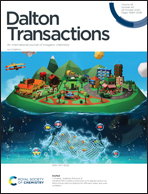Functionalisation of gold nanoparticles with ruthenium(ii) polypyridyl complexes for their application in cellular imaging†
Abstract
Two new dinuclear Ru(II) polypyridyl complexes containing an alkyl disulphide functionalised bipyridine-based ligand and either 1,10-phenanthroline (phen) or 1,4,5,8-tetraazaphenanthrene (TAP) as ancillary ligands have been synthesised and characterised. Their attachment onto the surface of gold nanoparticles (AuNPs, average diameter of ca. 2.5 nm) resulted in the formation of two new water-soluble Ru(II)-AuNP conjugates that combine the advantageous properties of both moieties. Both free complexes show the attractive photophysical properties of Ru(II) polypyridyl complexes and a rapid cellular uptake in HeLa cervical cancer cells. However, their corresponding gold conjugates displayed lower quantum yields than those determined for the free complexes presumed to be due to an energy transfer quenching of the Ru(II) luminescence by interaction with the gold surface. Despite their diminished luminescence, confocal fluorescence microscopy studies revealed that the Ru(II)-AuNP conjugates are successfully internalised into HeLa cells and better tolerated than their free complex counterparts after 24 h incubation, which makes them potential luminescent nanomaterials for bioimaging applications.



 Please wait while we load your content...
Please wait while we load your content...